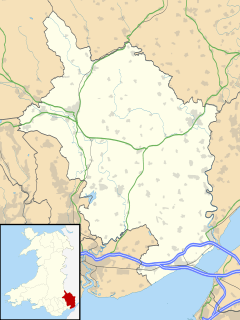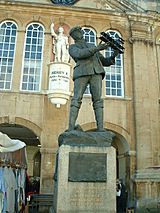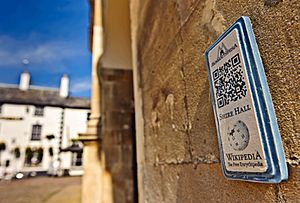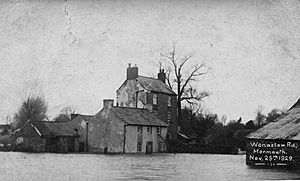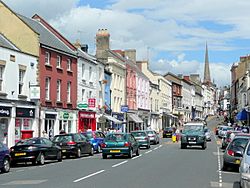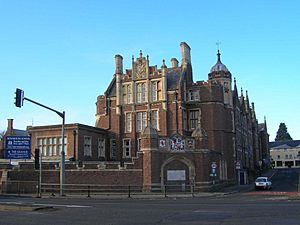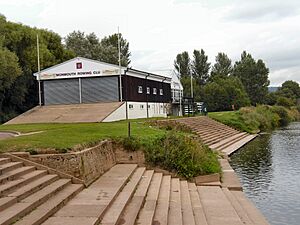Monmouth facts for kids
Quick facts for kids Monmouth
|
|
|---|---|
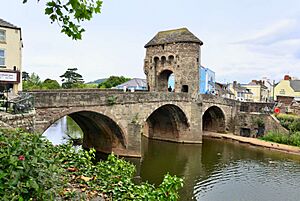 Monnow Bridge |
|
 Flag |
|
| Population | 10,508 (2011) |
| OS grid reference | SO505125 |
| Principal area | |
| Ceremonial county | |
| Country | Wales |
| Sovereign state | United Kingdom |
| Post town | MONMOUTH |
| Postcode district | NP25 |
| Dialling code | 01600 |
| Police | Gwent |
| Fire | South Wales |
| Ambulance | Welsh |
| EU Parliament | Wales |
| UK Parliament |
|
| Welsh Assembly |
|
| Website | www.monmouth.gov.uk |
Monmouth is a lively market town in Monmouthshire, Wales. It sits where the River Monnow meets the River Wye. The town is about 2 miles (3 km) from the border between Wales and England. In 2011, about 10,508 people lived there.
Monmouth was once the main town of historic Monmouthshire. It was built on the site of a small Roman fort called Blestium. The town grew bigger after the Normans built Monmouth Castle around 1067. The old Monnow Bridge is special because it's the only stone bridge with a gate still standing in Britain. Monmouth Castle was also the birthplace of King Henry V in 1386.
Contents
What's in a Name?
The name Monmouth comes from "Monnow-mouth." This means it's at the mouth of the River Monnow. The Welsh name for the river, Mynwy, probably meant "fast-flowing."
The town was first called Abermynwy in Welsh. This means "mouth of the Monnow." Later, by the 1600s, it changed to Trefynwy, meaning "Monnow town."
Monmouth's Past
Archaeologists have found many clues about Monmouth's early history. They have dug up sites along Monnow Street. Experts even say Monmouth is one of the top ten towns in Britain for archaeology!
Ancient Times
In 2013, archaeologists found signs of a Bronze Age boat-building community. They found three long channels next to a vanished lake. This was near the Parc Glyndwr housing site.
Later, they found remains of a Neolithic crannog. This was a dwelling built on stilts on a man-made island. It was in water up to 10 feet (3 meters) deep. Oak timbers were cut with stone axes to make the stilts. These timbers were dated to almost 5,000 years ago!
Roman Era
The first known settlement in Monmouth was a small Roman fort called Blestium. It was part of a network of military bases. These bases were set up on the edges of the Roman Empire. Roads connected Blestium to larger Roman towns like Gloucester and Caerleon.
Archaeologists have found Roman pottery and coins in the town centre. From the 2nd to 4th centuries, Monmouth was a centre for iron working. They used local iron ore and charcoal.
The Middle Ages
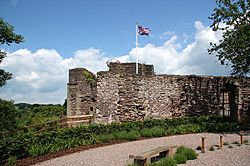
After the Romans left Britain, Monmouth was on the edge of the Welsh kingdom of Ergyng. There's a record of a 7th-century church in town. It was dedicated to the Welsh saint Cadoc.
In 1056, a Welsh prince named Gruffydd ap Llywelyn attacked the area. He was on his way to defeat the Earl of Hereford.
After the Norman conquest of England in 1066, William fitzOsbern was given the area. He was a close friend of William the Conqueror. He built a new Monmouth Castle. It had great views and helped control the rivers and local resources. The castle started as a motte and bailey castle. Later, it was rebuilt in stone.
A town grew around the castle. A Benedictine priory was also started around 1075. This priory might have been where the monk Geoffrey of Monmouth lived. He was born around 1100 and wrote a famous book called Historia Regum Britanniae.
Monmouth grew after it was mentioned in the Domesday Book. The area west of the river, called Overmonnow, also started to grow. The town was known for trading iron. Blacksmiths used local iron ore and charcoal. The waste from the forges, called cinders, was used in building. This is why a street is still called Cinderhill Street.
In 1233, a big battle happened in Monmouth. King Henry III's forces were defeated by Richard Marshal's troops. Around 1300, town walls were built. The Monnow Bridge was also made stronger. This bridge is now for people walking. It's the only fortified bridge like it in Britain.
King Edward II was held in Monmouth Castle for a short time in 1326. Later, the castle and town became part of the House of Lancaster. This happened when John of Gaunt married Blanche of Lancaster. John of Gaunt made the castle stronger. It became a favourite home for the House of Lancaster.
In 1387, Henry V was born in Monmouth Castle. He was John of Gaunt's grandson. Henry V later won the famous Battle of Agincourt in 1415. Monmouth remembers Henry V with Agincourt Square and a statue of him on the Shire Hall.
From the 14th century, Monmouth was known for making woollen Monmouth caps. But the town's growth slowed down after nearby areas were attacked by Owain Glyndŵr's supporters around 1405. Monmouth itself was not attacked.
After the Middle Ages
In 1536, King Henry VIII made new laws that joined England and Wales more closely. Monmouth became the county town of a new area. The town also got to send a representative to the English Parliament.
In 1605, King James I gave Monmouth a special town charter. This document said Monmouth should always be a "town and borough of Peace and Quiet." A map from 1610 shows the town looking much like it does today. Monnow Street was a wide market street.
Monmouth School was started by William Jones in 1614. During the English Civil War, Monmouth Castle was captured three times. After the wars, the castle was partly destroyed. But the town itself became richer.
Great Castle House, built in 1673, is now home to the oldest regiment in the British Army. The Shire Hall was built in 1724. It was used for local courts and had a market underneath.
By the late 1700s, Monmouth was a popular place for visitors. They came to enjoy the "Wye Tour" by boat. Famous poets like William Wordsworth and artists like J. M. W. Turner visited the area.
The 19th and 20th Centuries
In 1802, Admiral Horatio Nelson visited Monmouth. He knew how important the local forests were for building ships. A Naval Temple was built in his honour on Kymin Hill.
In 1840, a famous trial happened at Monmouth's Shire Hall. Chartist protesters John Frost, Zephaniah Williams and William Jones were sentenced for their part in riots. Their sentences were later changed.
Before 1857, Monmouth had a local constable to keep order. William Fuller was a constable for over twenty years. He also worked as a fire chief and market clerk. He even rescued people from drowning!
Four railways were built to serve Monmouth between 1857 and 1883. But all of them closed between 1917 and 1964.
In the late 1800s and early 1900s, Monmouth had strong ties to the Rolls family. They lived just outside town. In 1904, Charles Rolls started the famous car making business. He died in a plane crash in 1910, at age 32. A statue of him stands in Agincourt Square.
St Mary's Church has a memorial to the men lost on HMS Monmouth. This ship sank in 1914 during a battle. Seven Royal Navy ships have been named after the town.
Monmouth was a quiet town for most of the 20th century. Passenger train services ended in 1959. But road connections improved with the new A40 road in 1966. This helped the town grow. New areas were built outside the old town centre.
Monmouthpedia
Monmouth is special because it was the first town to have a "MonmouthpediA" project. This project created Wikipedia articles about interesting places and things in the town. It uses QRpedia QR codes. You can scan these codes to read articles in English, Welsh, or other languages.
Monmouth's Location
Monmouth is built on Old Red Sandstone rock. It's where the River Wye meets the River Monnow. The smaller River Trothy also flows into the Wye nearby. South of the town, the Wye flows through a deep gorge.
The town is surrounded by wooded hills. These include Buckholt Wood, The Kymin, and The Graig. The town centre is on a low area between the Wye and Monnow rivers. Because of this, it has often suffered from floods. The open fields north and south of town, called Vauxhall Fields and Chippenham, have stayed undeveloped.
Monmouth's weather is influenced by the Severn Estuary. It's milder than areas further inland. The average temperature in January is about 7.3°C (45.1°F). In July, it's around 22.0°C (71.6°F). The town gets about 1504 hours of sunshine each year.
Getting Around
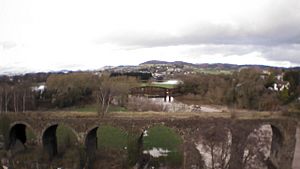
Since 1966, the A40 dual carriageway road goes past Monmouth. It connects to the M50 motorway at Ross-on-Wye. South of town, the road goes through a short tunnel. The A466 road also crosses the A40. It links Chepstow and Hereford.
The closest airports are Bristol Airport (41 miles/66 km), Cardiff Airport (49 miles/79 km), and London Heathrow Airport (120 miles/193 km). Buses run between Monmouth and nearby towns like Hereford, Ross-on-Wye, Chepstow, and Newport.
Monmouth has not had passenger train services since 1959. Its main railway station, Monmouth Troy, was later used for coal. The building has now been moved to a heritage railway. Another station, Monmouth May Hill, was on the other side of the Wye.
How Monmouth is Governed
Monmouth is managed by Monmouthshire County Council. This is one of 22 local authorities in Wales. The town elects five county councillors. As of March 2024, three are Welsh Labour, two are independent, and one is Welsh Conservative.
The town also has its own town council with 19 councillors. The mayor of Monmouth for 2023/2024 is Councillor Tom Kirton.
Monmouth had a mayor and local leaders in medieval times. It got its first official charter from Henry VI in 1447. The town was first represented in Parliament in 1536.
Over time, the way Monmouth was governed changed. In 1996, Monmouthshire became part of Wales for administrative purposes. This cleared up old questions about whether it was part of England or Wales.
Monmouth's Economy
Monmouth grew mainly as a market town and farming centre. It was not a big industrial town. The wool industry was important early on. The town was famous for making knitted and felted Monmouth caps from the 15th century.
Historically, Monmouth also had iron and tinplate factories. There were also paper and corn mills. The town was an important river port. It had warehouses along the Wye, which were later removed for the A40 road.
Today, Monmouth is mostly a centre for service industries and tourism. Its good roads mean people can easily travel to bigger cities for work. The Monmouth and District Chamber of Trade and Commerce helps local businesses.
The town has many shops, both big chains and local ones. Most are on Monnow Street. There are supermarkets, banks, cafes, and restaurants. Church Street is a cobbled street with craft shops and a book shop. Monmouth has been a Fairtrade town since 2005. A market is held near the Monnow Bridge.
People of Monmouth
In 2001, about 8,877 people lived in Monmouth. About 19.8% were 15 or younger. The average age was 42. The town's population grew by 61% between 1961 and 2001.
Learning in Monmouth
Monmouth has three primary schools: Kymin View, Osbaston, and Overmonnow.
Monmouth Comprehensive School provides secondary education. It had over 1,600 students in 2012. For those who want to learn in Welsh, Ysgol Gyfun Gwynllyw in Pontypool is available. Monmouth also has independent schools, including the Monmouth Schools. These are boarding and day schools.
Faith in Monmouth
In 2001, most people (74.2%) in Monmouth said they were Christian. About 16.7% said they had no religion. Other religions like Islam, Sikhism, and Buddhism were also present.
Monmouth has churches for several Christian groups. The Priory Church of St Mary is a Church in Wales church. It was founded as a Benedictine priory around 1075. It was rebuilt in 1737 and again in 1882. Its spire is a famous landmark. Other Anglican churches include St Thomas' at Overmonnow.
St Mary's Roman Catholic Church was the first Catholic church built in Wales after the Reformation. This happened after laws against Catholics were relaxed in 1778. The Monmouth Methodist Church and the Monmouth Baptist Church are also in town.
Culture and Events
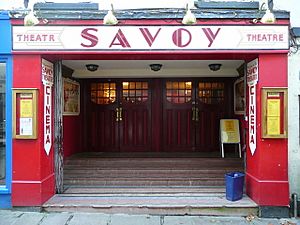
The Savoy Theatre is the oldest working theatre in Wales. Monmouth also has the Blake Theatre. Local groups include the Monmouth Operatic Society and Monmouth Choral Society.
The Monmouthshire Show is a big annual event. It has been held since 1919, but its history goes back to 1857. It's the largest one-day agricultural show in Wales. It has over 350 trade stands.
The Monmouth Museum has a large collection of items related to Horatio Nelson. It also displays the only known original Monmouth cap from the 16th century. The museum is moving to the Shire Hall. A small Regimental Museum is in Great Castle House.
The Monmouth Music Festival is a free nine-day music festival. It has been running since 1982. It's one of the largest free music festivals in Europe. The town also hosts the Rockfield Country Music Festival.
An annual regatta is held on the River Wye in May. A raft race also takes place each year. Monmouth was named one of the best places to live in Wales in 2017. In 2020, Monmouth became the first "Bee Town" in Britain. It holds an annual Bee Festival.
Monmouth is twinned with Carbonne in France and Waldbronn in Germany.
Sports, Fun, and Visitors
Monmouth is home to Monmouth Town F.C., a football club started around 1905. They play at the Chippenham Sports Ground. The town has a leisure centre with a swimming pool. There's also an 18-hole golf course.
Monmouth has cricket, bowls, and rugby clubs. The Welsh Men's National Lacrosse team trains in Monmouth. The town has a strong rowing tradition on the River Wye. The Monmouth Rowing Club was founded in 1928.
Monmouth has been a popular tourist spot for about 200 years. It's close to the Forest of Dean and Wye Valley. Visitors can see the castle, museum, Nelson Garden, and Shire Hall. The area is also great for walkers. The Offa's Dyke Path and the Wye Valley Walk both pass through the town.
Famous People from Monmouth
Many interesting people are connected to Monmouth. Geoffrey of Monmouth, a writer born around 1100, is believed to be from the area. King Edward II was briefly held at the castle. Henry V, the hero of the Battle of Agincourt, was born in the castle in 1386.
Horatio Nelson visited Monmouth several times. After his death, the garden where he dined was named the Nelson Garden. William Allen, a hero from the Battle of Rorke's Drift, is buried in Monmouth Cemetery.
Rockfield Studios, just outside town, has hosted famous bands like Queen and Oasis. Musician Dave Edmunds lives there. Other famous residents include TV presenter Kate Humble and comedian Miles Jupp.
Images for kids
-
View westwards over Monmouth from The Kymin
-
Church Street, a pedestrian-friendly shopping area
-
Remains of the Great Tower of Monmouth Castle
-
Wye Bridge on the River Wye
See also
 In Spanish: Monmouth para niños
In Spanish: Monmouth para niños


